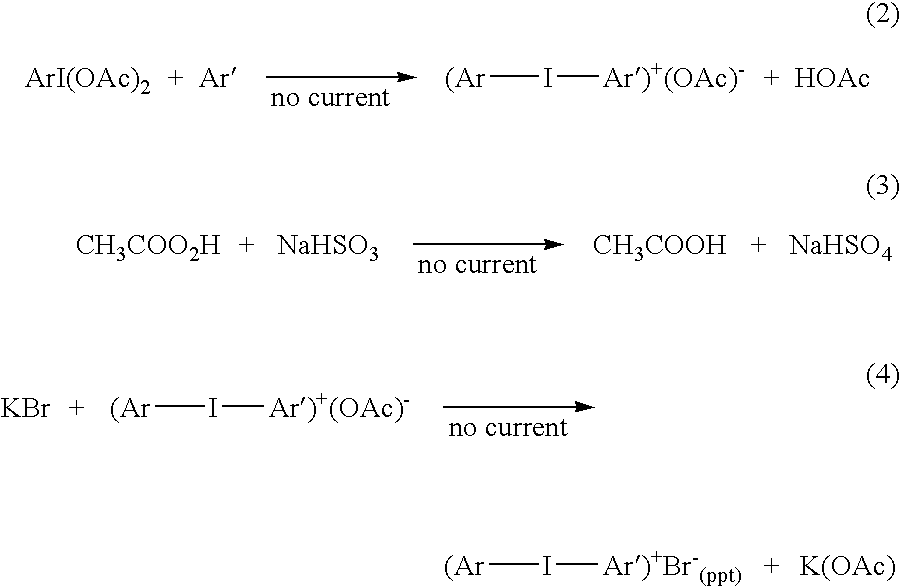Process for the production of diaryl iodonium compounds
a diaryl iodonium and compound technology, applied in the field of electrochemical methods of producing diaryl iodonium compounds, can solve the problems of high cost of subsequent isolation and purification of iodosyl compounds, significant risk of spontaneous detonation, and electrochemical processes
- Summary
- Abstract
- Description
- Claims
- Application Information
AI Technical Summary
Benefits of technology
Problems solved by technology
Method used
Image
Examples
example 1
[0033] In an undivided electrochemical cell was placed 3.582 grams iodobenzene (0.0176 moles), 1.47 grams of thiophene (0.0176 moles), 7.4 grams sulfuric acid, 42 grams glacial acetic acid, and 6.5 grams acetic anhydride. Carbon electrodes were used for the cathode and the anode. The mixture was electrolyzed at 15° C. and a constant current until 1,003 Coulombs of charge (25% of theoretical) had passed, assuming two moles of electrons are needed per mole of iodosyl compound and one mole of iodosyl compound is needed per mole of iodonium compound. Given this amount of electrical power, the voltage rose from 8.5 volts to 24 volts as the current fell. The current was subsequently turned off. The reaction mixture was opaque with tarry material in the liquid and on the electrodes. 150 ml of water and then 150 ml of hexane were added to the reaction mixture and the resultant mixture was well stirred. The reaction mixture separated into organic and aqueous phases. To the aqueous phase was ...
example 2
[0034] In an undivided electrochemical cell was placed 3.646 grams iodobenzene (0.0179 moles), 7.4 grams sulfuric acid, 42 grams glacial acetic acid, and 6.5 grams acetic anhydride. Carbon electrodes were used for the cathode and the anode. The mixture was electrolyzed at 15° C. and a constant current until 4,000 Coulombs of charge (93% of theoretical) had passed, assuming two moles of electrons are needed per mole of iodosyl compound and one mole of iodosyl compound is needed per mole of iodonium compound. The current was subsequently turned off. To the resulting mixture 1.5 grams of thiophene (0.0179 moles) was added and well stirred. 150 ml of water and then 150 ml of hexane were added to the reaction mixture and the resultant mixture was well stirred. The reaction mixture separated into organic and aqueous phases. To the aqueous phase was added 0.425 grams of NaHSO3 and the reaction mixture was stirred. An excess of KBr was added and the phenyl thienyl iodonium cation was recove...
PUM
| Property | Measurement | Unit |
|---|---|---|
| electric potential | aaaaa | aaaaa |
| pressure | aaaaa | aaaaa |
| temperature | aaaaa | aaaaa |
Abstract
Description
Claims
Application Information
 Login to View More
Login to View More - R&D
- Intellectual Property
- Life Sciences
- Materials
- Tech Scout
- Unparalleled Data Quality
- Higher Quality Content
- 60% Fewer Hallucinations
Browse by: Latest US Patents, China's latest patents, Technical Efficacy Thesaurus, Application Domain, Technology Topic, Popular Technical Reports.
© 2025 PatSnap. All rights reserved.Legal|Privacy policy|Modern Slavery Act Transparency Statement|Sitemap|About US| Contact US: help@patsnap.com

